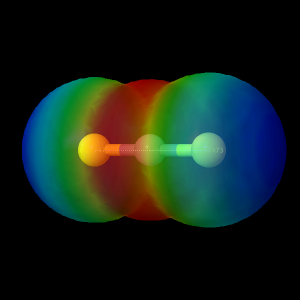Carbon disulfide is colorless, volatile and considered highly toxic. The molecule is covalently bonded and consists of one carbon atom double-bonded to two sulfur atoms. The Lewis structure of the molecule is shown below.

Although the above structure depicts the correct bonding structure of the molecule, it is not an accurate depiction according to the molecular orbital (MO) theory. To better understand the nature of the bonding and anti-bonding molecular orbitals, three levels of theory were performed on an initial guess of the molecular structure. These three levels (Molecular Mechanics, MOPAC3, and Ab initio) served as the
By clicking on the button below, a figure of the molecule can be viewed that highlights the partial atomic charges of each atom, the physical dimensions of the molecule, and a visual representation of the electrostatic potential field surrounding the molecule.
The geometry of the structure shows a linearity among the atoms. This property diminishes any molecular dipole moment. Partial atomic charges are shown in Figure 1, where the carbon atom holds a negative partial charge and the two sulfur atoms (flanking the carbon on opposite sides of one another) are partially positive. This indicates that there is greater electron density between the carbon atom and each sulfur atom.
The optimized geometry of the structure
shows that the C-S
bond lengths are equivalent in distance between
nuclei. The electrostatic
potential is shown as an all-encompassing electric field
surrounding the
molecule. The color gradient of the field represent
the changes in the
potential energy in relation to the charge
distribution. This attribute
coincides with the partial atomic charges.
By clicking on the button below, a figure of the molecule can be viewed that shows a visual representation of the highest occupied molecular orbital (HOMO).
The optimized geometry and double zeta
valence (DZV) basis set were used to obtain the highest
occupied molecular
orbital (HOMO) for the molecule. The balloon-like
surfaces above and
below each sulfur atom represents electron occupied
pi-orbitals. The
figure represents the stage when the valence electrons are
in the highest energy
state. As shown in Figure 2, the red and blue colored
orbitals represent
the difference in phase for each pi-orbital.
By clicking on the button below, a figure of the molecule can be viewed that shows a visual representation of the lowest unoccupied molecular orbital (LUMO).
Similar to the figure of the HOMO, the
lowest unoccupied molecular orbital (LUMO) is shown using
the optimized
geometry and DZV basis set. Molecular orbitals are
shown surrounding all
atoms in the molecule, which is consistent with the
molecular orbital (MO)
theory, where the LUMO is the lowest energy state of
unoccupied orbitals.
According to the MO theory, delocalized electrons become
excited and transition
from the HOMO to the LUMO. This transition energy can
be approximated
using the ab initio level of theory.
References:
1.
Mihalick, J. Gutow, J. Quantum Calculations 2016, p 1-12.
2.
Chlorine. Chlorine,
http://webbook.nist.gov/cgi/cbook.cgi?id=7782-50-5 (accessed Mar 3, 2016).
3.
Carbon disulfide. Carbon disulfide,
http://webbook.nist.gov/cgi/cbook.cgi?id=75-15-0 (accessed Mar 2, 2016).
4.
Benzene, nitro-. Benzene, nitro-,
http://webbook.nist.gov/cgi/cbook.cgi?id=c98953 (accessed Mar 3, 2016).
You may look at any of these intermediate views again by clicking on the appropriate button.

If your browser/OS combination is Java capable, you will get snappier performance if you use Java